NRAO eNews
May 2009 • Vol. 2, Iss. 5
- Upcoming Events
- Call for Proposals for NRAO Telescopes
- The 4th NAASC Conference: Assembly, Gas Content, and Star Formation History of Galaxies
- A Third ALMA Antenna Joins the Growing Array
- GBT High-Frequency Efficiency Improvements
- VLBA Astrometry Workshop
- Increased Reimbursement Limit for NRAO's Foreign Telescope Travel Fund
- 2009 Grote Reber Medal Awarded to Barry Clark
- Career Opportunities
- Past Issues
- Contact the Editor
- Subscribe
- More Information
NRAO eNews: May 2009 • Volume 2, Issue 5

ALMA antennas at the Operations Support Facility in northern Chile.
(Photo courtesy L. Knee)
Upcoming Events
 The EVLA Vision: Stars On and Off the Main Sequence
The EVLA Vision: Stars On and Off the Main Sequence
May 26-28, 2009 | Socorro, NM
 Advancing Chemical Understanding through
Advancing Chemical Understanding through
Astronomical Observations
May 26-29, 2009 | Green Bank, WV
 Observing with ALMA
Observing with ALMA
June 1-3, 2009 | Hamilton, Ontario
 American Astronomical Society
American Astronomical Society
June 7-11, 2009 | Pasadena, CA
 SKA Town Hall at the AAS
SKA Town Hall at the AAS
June 9, 2009 | 12:45 PM – 1:45 PM | Pasadena, CA | Ballroom A
 Millimeter and Submillimeter Astronomy at High Angular Resolution
Millimeter and Submillimeter Astronomy at High Angular Resolution
June 8-12, 2009 |
Academia Sinica, Taipei, Taiwan
 NAIC-NRAO School on Single-Dish Radio Astronomy
NAIC-NRAO School on Single-Dish Radio Astronomy
July 12-18, 2009 | Arecibo Observatory, Puerto Rico
 VLBA Astrometry Workshop
VLBA Astrometry Workshop
July 21-23, 2009 | Socorro, NM
 Assembly, Gas Content and Star Formation History of Galaxies
Assembly, Gas Content and Star Formation History of Galaxies
September 21-24, 2009 | Charlottesville, VA
Call for Proposals for NRAO Telescopes
Joan Wrobel and Toney Minter
The NRAO announces the Call for Proposals for trimester 09C. The call is open now and will close on 1 June 2009 at 17:00 EDT (21:00 UTC).
- Details of the call for the Green Bank Telescope (GBT) for observing from 1 October 2009 through 31 January 2010.
- Details of the call for the Very Large Array (VLA) and the Very Long Baseline Array (VLBA).
- Observing periods and VLA configurations were announced in the April 2009 eNews.
The 4th NAASC Conference: Assembly, Gas Content and Star Formation History of Galaxies
Aaron Evans
http://www.nrao.edu/meetings/galaxies09/
September 21-24, 2009
Omni Hotel, Charlottesville, Virginia
In the last two decades, the availability of large ground-based and space-based facilities, and improved theoretical modeling, have led to significant advances in our understanding of star formation, the gas cycle in galaxies, and galaxy assembly and evolution over cosmic time. With the next generation of long-wavelength ground- and space-based facilities set to become fully operational in the first half of the coming decade, the time is ripe to review the theoretical and observational progress that has been made in the areas of extragalactic star formation, interstellar gas properties and galaxy assembly, and to assess where science with facilities such as ALMA, EVLA, Herschel Space Telescope, and the JWST are likely to contribute transformational understanding in these areas.
Keys issues to be addressed are:
- Gas content, scaling relations, and diagnostics of the star formation rate at low and high redshift
- Advances in the theory and modeling of galaxy assembly and star formation on small and large scales
- The role of feedback from stellar winds, SNe and AGN in regulating star formation;
- The role of accretion and mergers in driving galactic evolution
A major goal of this meeting is to highlight the capabilities of ALMA, and its synergy with the EVLA, Herschel, JWST, etc., in driving transformational science in these key areas in the next decade.
A Third ALMA Antenna Joins the Growing Array
Al Wootten
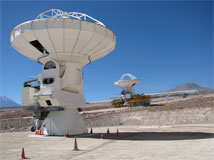
Figure 1. The second Vertex antenna accepted by ALMA moves on a transporter toward the Operations Support Facility. In the foreground stands the next antenna in the queue. Photo courtesy N. Emerson.
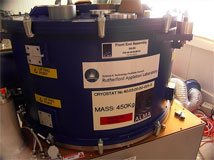
Figure 2 The third ALMA Front End was shipped intact from the European Front End Integration Center and arrived in fine shape. After passing its tests, it is ready for installation in the third ALMA antenna. Photo courtesy D. Barkats.
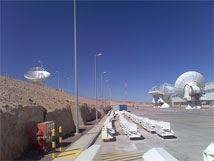
Figure 4. The two antennas facing the camera were the first accepted by ALMA: an NAOJ antenna (left) and an NRAO antenna (right). In the distance is the second NRAO antenna accepted by ALMA. In the foreground is Vertex No 4, undergoing tests but not yet accepted by ALMA. Photo courtesy L. Knee.
On 29 April 2009, the second Atacama Large Millimeter/submillimeter Array (ALMA) production antenna designed and built by the Vertex division of General Dynamics Corp. under contract with Associated Universities, Inc. conditionally passed its acceptance tests and was accepted by the project. An ALMA transporter moved this antenna to foundation No. 4 at the nearby Operations Support Facility (OSF) and antenna outfitting began immediately. This antenna will be equipped with the Front End recently delivered from the European Front End Integration Center at Rutherford Appleton Labs.
With the arrival of the pedestal structure on 18 April, all the major parts for the first European antenna had arrived at the contractor's OSF site.
The two antennas that have been outfitted and characterized by the ALMA teams over the past months now have their surfaces set to much better than the 25 micron specification when pointed at an elevation of 50 degrees, the so-called "rigging angle." Both antennas have had their individual parameters— e.g., pointing and focus models—determined through total power tests run by the AIV (Assembly, Integration and Verification) team led by Joe McMullin, and by the science team led by Alison Peck. As a measure of merit of these models, both antennas were pointed at the holography tower in early April and 'static fringes' were observed from the beacon used for holography. Doing this on an astronomical source requires good focus and pointing. During April, numerous observations of stellar SiO masers have yielded good radiometric pointing models. On 30 April, both antennas were pointed at an astronomical source, Mars, and static fringes were observed. Present at the event were Gene Duvall, Dick Sramek, Lewis Knee, Norman Saez, and Hector Alarcon with off-site support from Peter Napier and Darrel Emerson. The team will proceed with the next steps, culminating with ALMA software controlling all aspects of the observation—in the recent Mars observation, e.g., the geometric delay in the signal paths between the two antennas was calculated independently. The next software implementation will contain all of the functionality to do this and other calculations automatically. When this occurs in June, we will refer to the fringes as "dynamic."
GBT High-Frequency Efficiency Improvements
Todd Hunter and Fred Schwab
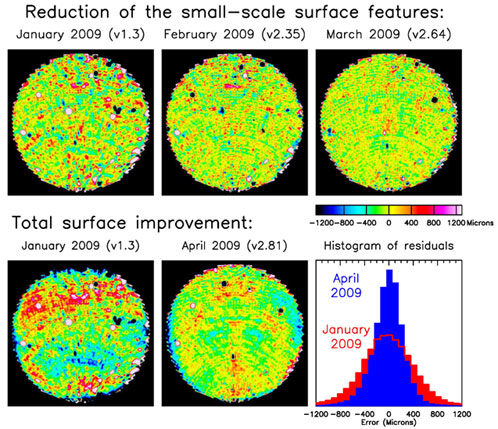
Top row: Holography surface maps of the GBT, each of which has had the large-scale features removed. Top left: the initial surface as it was before any adjustments to the actuator table. Top center: after the first adjustment. Top right: after the second adjustment. Bottom left: the initial surface including large-scale features. Bottom center: the surface after the third adjustment. Bottom right: histogram showing the net improvement from January to April.
The Precision Telescope Control System (PTCS) project team continues to improve the GBT surface accuracy using phase-coherent holography. In the February 2009 E-News, we reported a 40% increase in the 90 GHz sensitivity. We have since completed more iterations of surface measurements and corrections. The 90 GHz aperture efficiency is now factor of 2 higher than 2008 levels and is estimated to be 22%. Likewise, the Q-band efficiency has increased from 44% to ~51%. These improvements are consistent with a reduction of the total surface error from 390 to ~300 microns rms. According to the latest holography maps, the inner 56 meter diameter of the dish (one third of the total area) appears to have reached the goal of 210 microns rms. Improving the outer portion of the dish to this level is the next challenge.
In our initial iterations, we filtered out large-scale features in the holography maps in order to restrict our corrections to the small-scale errors. The top row of images in the Figure shows the progress made in reducing the small-scale errors from January to March. In early April, we averaged together two surface maps before deriving actuator corrections. We also corrected the large-scale features that have persisted in the maps, as demonstrated in the lower left image in the Figure. This technique yielded surface version 2.81 which became the default on April 10. The lower right panel of the Figure shows the improvement in the form of a histogram of the residual surface errors. The current best surface (v2.93) was installed on May 11 and tested with MUSTANG just prior to its removal from the GBT.
The holography receiver will remain on the telescope during the Summer months during which we plan to acquire more maps of the latest surface. Most of the maps recorded to date used a geostationary satellite located close to the highest possible elevation from Green Bank (45 deg). In the April 13th map shown, we successfully targeted a satellite at 22 degrees elevation. We will continue to explore the repeatability of the surface maps, determine how well the surface retains its figure, and try to produce additional corrections. Until MUSTANG returns to the telescope, we will use the Q-band receiver to gauge improvements and measure a new gain curve. Meanwhile, the maintenance team is fixing a few failed actuators identified from our maps. Additional information about PTCS projects is available at http://www.gb.nrao.edu/ptcs/.
VLBA Astrometry Workshop
M. Claussen and W. Brisken on behalf of the LOC and SOC
NRAO will host a workshop titled "New Science Enabled by Microarcsecond Astrometry" at the Pete V. Domenici Science Operations Center in Socorro, NM from July 21 to 23, 2009. Topics of the workshop will include: planet searches, star formation, stellar astrophysics, Galactic structure, motions of local group galaxies, black holes and neutron stars, megamasers, reference frame ties, and astrometry instrumentation. The workshop’s opening day will be devoted to invited talks on a range of astrometry topics. Most of the second day will consist of breakout sessions with the aim of building new astrometry collaborations. The state of the VLBA and its ongoing sensitivity upgrade project will be described, and the fundamentals of VLBI astrometry will be explained. There will also be program slots for ~ 12 contributed talks, a change since the first announcement. Please submit an abstract if you wish to talk by 1 June through the registration web page. We will let all potential speakers know if their paper has been accepted by 15 June. We will also have room for about 25 posters. All poster presenters will be given up to 2 minutes to "advertise" their poster.
Tentative list of invited speakers and topics:
- Andreas Brunthaler (MPIfR): Extra-galactic astrometry
- Andy Boden (Michelson Science Center): Optical/IR interferometry
- Laurent Loinard (UNAM): Astrometry to star forming regions
- Steve Unwin (JPL): SIM Lite / Space-based astrometry
- Geoff Bower (UC-Berkeley): Planet searching
- Jim Condon (NRAO): Megamaser cosmology project
- Ken Johnston (USNO): Reference frame ties
- Mareki Honma (NAOJ): Galactic structure
- Hideyuki Kobayashi (NAOJ): VERA
- Karl Menten (MPIfR): TBA
- Shami Chatterjee (Cornell Univ.): Pulsar astrometry
- Andy Gould (Ohio State): OGLE
Space at the workshop will be limited, and registration will be on a first-come-first-served basis, so please register early via the form at the conference web page. There will be a registration fee of US$120.
See http://www.aoc.nrao.edu/events/astrometry/ for details.
Increased Reimbursement Limit for NRAO's Foreign Telescope Travel Fund
Harvey Liszt
Effective immediately, the maximum reimbursement for air travel to foreign radio telescopes under the NRAO Foreign Telescope Travel Fund has been increased to $1350. For information on this program see http://www.nrao.edu/admin/do/foreign_telescope_fund.shtml.
2009 Grote Reber Medal Awarded to Barry Clark
Ken Kellermann
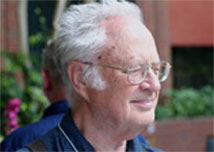
Dr. Barry Clark
The 2009 Grote Reber Gold Medal for lifetime innovative contributions to radio astronomy has been awarded to Dr. Barry Clark, an Emeritus Scientist at NRAO in Socorro, New Mexico. Clark is being honored for his many pioneering developments to radio interferometry and synthesis imaging, over a career spanning more than half a century. Throughout his career Barry has tackled the most difficult problems, leaving the easy ones for others. Although he is known as a man of few words, Dave Jauncey a long time colleague commented that these words "were most certainly worth listening to!"
Barry received his B.S. and Ph.D. degrees in astronomy from Caltech and MIT in 1959 and 1964 respectively. His scientific career has extended over a half-century starting with his research on the solar corona and the Galactic magnetic field while still an undergraduate at Caltech. As a graduate student, Barry used the Caltech radio interferometer to study Galactic atomic hydrogen clouds, and suggested that interstellar hydrogen is found in two distinct temperature phases — thus leading to our current understanding of the multiple phases of the interstellar medium.
After receiving his Ph.D. in 1964, Barry came to NRAO where he has remained through the present. Soon after he arrived at NRAO, he led the development of the world's first digital recording, software correlator interferometer system and the subsequent enhancements to its sensitivity. He is probably best known, however, as the intellectual power behind the Very Large Array (VLA). Later, he led the design of the Very Long Baseline Array (VLBA).
The 2009 Reber Medal will be presented to Barry Clark on 5 August at the meeting of the International Astronomical Union in Rio de Janeiro, Brazil. The Reber Medal was established by the Trustees of the Grote Reber Foundation to honor the achievements of Grote Reber and is administered by the Queen Victoria Museum in Launceston, Tasmania. Nominations for the 2010 Medal may be sent to Martin George, Queen Victoria Museum, Wellington St, Launceston, Tasmania 7250, Australia or by e-mail to: martin@qvmag.tas.gov.au to be received no later than 15 November 2009.
Career Opportunities
New Postings
Scientist/A (Scientific Leader, High Frequency Focal Plane Array Development Program): The National Radio Astronomy Observatory is beginning a program to develop focal plane arrays for the Green Bank Telescope, beginning with a 3mm array. We are looking for an energetic individual to provide scientific leadership for the focal plane array development program, particularly for the GBT's high frequency range.
Software Engineer II: The Computing Division of the EVLA is looking for a Software Engineer to assist in the design and development of control software for a suite of new instrumentation being developed for the Very Long Baseline Array (VLBA).
Web Analyst/Developer: The North American ALMA Science Center is seeking a Web Analyst/Developer to work in consultation with observatory scientific, technical, and design staff to plan, develop, and maintain websites and web portals that communicate technical information to external users of observatory research facilities.
ALMA Commissioning Scientists: The Joint ALMA Office invites applications for the position of Commissioning Scientists to be based in Santiago, Chile. These are international staff positions in the ALMA Project, the world's most sensitive mm/submm interferometer, which is currently under construction in northern Chile. The role of ALMA Commissioning Scientists is to assist the Project Scientist and Deputy Project Scientist in planning and executing the scientific commissioning of ALMA.
ALMA Science Operations Astronomers: ALMA is seeking ALMA Science Operations astronomers who will work as Astronomer on Duty (AoD) at the ALMA Operations Support Facility (OSF), and spend part of their time at the ALMA Regional Centers (ARCs) as well as in the ALMA offices in Santiago for research and data quality control.
ALMA System Engineers: ALMA is seeking two System Engineers to join the team in Chile in support of the construction, commissioning and operational phases of the project. The positions involve duties in ALMA partner regions, Europe, East Asia, and North America, in the form of frequent missions to contribute to the production and integration activities of the ALMA sub-systems. Frequent missions to the ALMA construction site near San Pedro de Atacama, northern Chile, are foreseen to participate in the equipment acceptance and in the integration and verification tasks.
Assistant Scientist: The Scientific Services Division is seeking an energetic person to join the scientific staff in Green Bank, West Virginia to support observers who come to the telescope as well as work on a diverse variety of projects. This may include the development and commissioning of new instrumentation on the telescope, working with the engineering staff to improve the overall telescope performance, and aiding with the data reduction pipelines needed for the GBT.
Head of the Joint ALMA Observatory Archive Operations Group: ALMA is seeking a Data Manager for the Joint ALMA Observatory (JAO) to lead the Archive Group and be responsible for the set-up and maintenance of the services of the JAO archives as well as for pipeline operations and data quality assurance. The Data Manager will supervise the activities of the archive operations, database contents management and pipeline operations.
Software Engineer (KFPA): The K-band Focal Plane Array Project at the Robert C. Byrd Green Bank Telescope (GBT) is seeking a Software Engineer to develop monitor and control software. The seven beam array under development will improve mapping speed and map calibration for extended molecular regions. Upon completion and commissioning of the seven beam array, work will commence on a larger array and complementary hardware infrastructure.
Systems Astronomers - Joint ALMA Observatory: ALMA is seeking ALMA system astronomers who will be the experts on the performance of ALMA, and will provide advice and assistance to ALMA operations working closely with the system engineers in the Department of Technical Services.
 Zoom
Zoom
